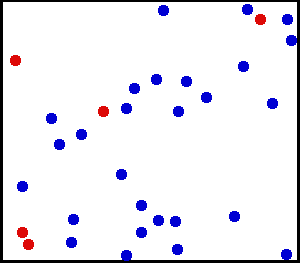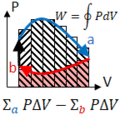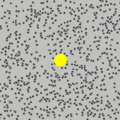Gases and gas laws
| |
Subject classification: this is a science resource . |
Gases and their Properties
A gas is one of the states of matter. As such, it has unique physical properties.
Gases assume the volume and the shape of their container and as such mix evenly and completely. In addition, a gas is the most compressible state of matter (having the lowest density).
The individual molecules which make up a gas can make collisions with the edges of their containers. As such, they exert a force on the container. We call this force the pressure of a gas.
Gasses are the only state of matter that are governed by universal laws. The universal gas constant, R, is unique in that it has relevance to all gasses.
Ideal Gases
A hypothetical "ideal" gas would satisfy the following requirements:
1. A gas molecule has neglible volume, and is separated from other molecules in a gas by distances far greater than its own size.
2. A gas molecule travels in random directions and frequently collide with other gas molecules. These collisions are perfectly elastic, which means that kinetic energy is conserved.
3. Gases exert neither attractive nor repulsive forces on one another.
4. The average kinetic energy of the molecules is proportional to the temperature of the gas.
However, gases do exert forces on one another: that is how they can condense into liquids. And a gas does have volume which is not negligible. This is deviation from ideal behavior (real gas behavior).
Gas Laws
The following gas laws assume ideal behavior:
Avogadro's Law: If temperature and pressure are constant, then the amount of moles of gas in a system is directly proportional to the volume of the system.
 represents the number of moles in the system.
represents the number of moles in the system.  represents the volume of the system.
represents the volume of the system. .
.
Boyle's Law: If temperature and the number of moles of gas are constant, then the pressure of a system is inversely proportional to the volume of the system.
 represents the pressure of the system.
represents the pressure of the system.  represents the volume of the system.
represents the volume of the system.
Charles's Law: If pressure and the number of moles are constant, then the volume of a system is directly proportional to the temperature of the system.
 represents the temperature of the system.
represents the temperature of the system.  represents the volume of the system.
represents the volume of the system. .
.
Gay-Lussac's Law: If volume and the number of moles of gas are constant, then the pressure of a system is directly proportional to the tempreature of the system.
 represents the temperature of the system.
represents the temperature of the system.  represents the pressure of the system.
represents the pressure of the system.
The Ideal Gas Law: When we combine together the above laws, we get the ideal gas equation, where P is pressure, V is volume, n is moles, T is temperature, and R is the gas constant, which has various values depending on the unit on pressure:

However, if we take into account some real behavior, we can get an improved version of the Ideal Gas Law. The observed pressure is less than the ideal gas law predicts because the molecules do have interactions with each other, and when they do, it will reduce collisions with the container, and low pressure. The volume is bigger than it should be, because the molecules take up space, which must be accounted for. So, the corrected equation, known as the van der Waals equation, is

The value of a depends on how strong the interactions are between molecules. The value of b has a rough correlation with molecular size.
Many other equations exist relating pressure, temperature and volume of gases. These equations of state are empirically derived and attempt to correct for the real behavior of gases. Some of these equations of state include: Redlich-Kwong, Soave-Redlich-Kwong, Peng-Robertson and the Virial equations of state among others.
Lab(s)
- Boyle's law lab that measure atmospheric pressure using a hospital syring with weights used to enhance pressure.
Images from commons
-

Translational motion.gif (click for animation)
-

Gas thermometer and absolute zero.jpg
-

Boyle_air_pump.jpg
-

Boyles Law animated.gif (click for animation)
-

File:PdV_work_cycle.gif
-

Carbon_dioxide_pressure-temperature_phase_diagram.svg
-

Brownian motion large.gif
See Also
- Topic:Biochemistry